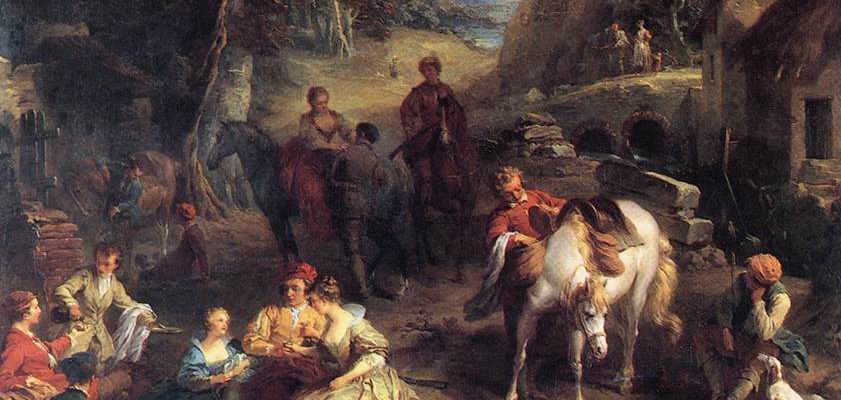2021 Festival Videos

A Baroque Pick-Nick
Program Notes
A Baroque Pick-Nick
Our present-day idea of a concert – an event at which members of the public gather and sit quietly in rows for the sole purpose of listening to music – was a relatively rare occurrence in the early 18th century. During the lifetimes of Bach, Handel, Vivaldi, and Telemann, performances would have been more usually given as accompaniments to other activities, including storytelling, worship, ceremony, socializing, and, last but not least, eating and drinking.
Throughout recorded history, music and dining seem to have gone together; depictions of banquet scenes in ancient Egypt, Greece and Rome include images and descriptions of singers and instrumentalists. Many surviving medieval castles and palaces contain musicians’ galleries placed above dining halls, with small windows into the main room allowing the musical ensembles to be heard but not seen. The practice of musicians accompanying dinner in well-born households became so widespread that by the mid-16th century collections of music known generically as Tafelmusik (table-music), written specifically for courtly banquets, had appeared in German-speaking lands, with significant contributions by Johann Hermann Schein, Michael Praetorius, and other well-known composers.
The culmination of the Tafelmusik genre was published in 1733 by Georg Philipp Telemann, director of church music in Hamburg for 46 years and perhaps the most prolific composer and publisher who ever lived. Telemann gave his collection the more pretentious French translation Musique de Table and solicited subscribers to a beautiful copper-engraved set of parts for the advance sum of 8 Reichsthaler, a very high price; he eventually secured nearly 200 customers from all over Europe including members of royalty, other nobility, and famous composers such as Handel, Pisendel, Quantz, and Blavet. The complete Musique de Table comprises about 4 1/2 hours of music divided into three “Productions”; each of these begins with an Ouverture followed by a series of Airs, sonatas, and other pieces for smaller ensembles lasting well over an hour, and finally a Conclusion for the full ensemble. The individual movements are quite long-winded especially if one takes all the repeats, presumably to avoid disturbing the conversation and digestion of dinner guests with too many pauses, so for present-day concert performances it is a good idea to select the offerings economically, as we have done here.
Another modern idea that did not exist in Baroque times was that of plagiarism – at the time it was perfectly legitmate for composers to “borrow” and rearrange material from other composers – this was generally viewed as a sign of respect rather than anything nefarious. One of the most copious borrowers was Handel himself, who certainly got his Reichsthaler’s worth from Musique de Table: the musicologist Max Seiffert has identified 18 themes taken from it in his later operas and oratorios. But Handel was also a victim of loose contemporary attitudes to intellectual property and attribution – quite a lot of his music got engraved and published without permission or compensation, and publishers would also put out other people’s music under his name to increase sales. One such instance, issued by the London publishing house Wright & Co in 1733, was entitled “Mr Handel’s Celebrated Water-piece (and A Choice Sett of Aires)” for solo trumpet and strings – the first movement is clearly lifted from the D-major suite of his famous Water Music from 1717, and the closing March is found in his 1730 opera Partenope, but the origins of the intervening Allegro, Air, and Bourée are unknown, possibly commissioned or composed by Mr. Wright himself. Taken as a whole the suite makes for easy listening, and copies of Wright’s offering may well have been purchased for use as table-music by households that had a trumpet player on staff.
It is well known that Antonio Vivaldi served for most of his adult life as a teacher at the Ospedale della Pietà, a Venice institution caring for orphaned or abandoned children, and that girls from the Pietà made up a “choir” of forty to sixty singers and instrumentalists who performed with great distinction for liturgical celebrations. Less clear is how this pool of talent came to exist or how their musical education at the Ospedale was paid for: one theory is that Venetian noblemen and clergy whose own illegitimate children were housed there took an interest in their progress and made lavish donations. Regardless, Vivaldi wrote a large quantity of virtuosic solo music for these “orphans” including about 50 bassoon concertos and 230 violin concertos. The bassoon concerto in Bb called La Notte (The Night) depicts an uneasy attempt at sleep, with much tossing and turning interrupted by ghouls and other apparitions. The flamboyant violin concerto in D, Il Grosso Mogul, was one of the few works by Vivaldi to be published in his lifetime; the young J.S. Bach was given a copy by his patron Prince Johann Ernst of Saxe-Weimar around 1714 and arranged it for organ solo. The title may refer to the leader of the Moghol empire, who was descended from Tamerlane and at the time ruled the entire Indian subcontinent.
It can be argued that no meal is complete without coffee nor a BHB concert without some Bach vocal music, so to complete our Pick-Nick we are including Ei! Wie schmeckt der Coffee süsse / Lieblicher als tausend Küsse (Ah! How sweet coffee tastes / Lovelier than a thousand kisses) from his well-known Coffee Cantata BWV 211, originally performed at the Kaffeehaus Zimmermann in Leipzig. As a bonus it happens to be in the relative minor key of the Telemann Ouverture-Suite, so why not?
Stephen Hammer